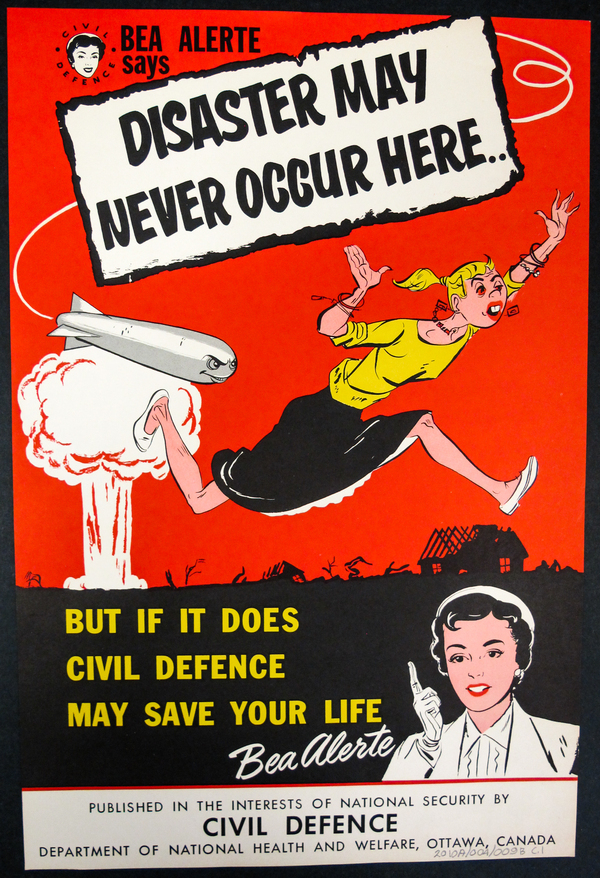Bea Alerte and Justin Case - Role Models for Citizenship
Each of the civil defence posters in the series presents the viewer with a comic scenario - typically, a sequence of disastrous events that might occur if the lessons of Bea Alerte and Justin Case are ignored. Along with their foils - a hapless and scruffy looking blond-haired woman and red-haired man - Bea Alerte and Justin Case offer a particular representation of Canadian identity. Based on a letter sent by F.F. Worthington to all Provincial Civil Defence Coordinators asking for feedback on four posters and six ink blotter designs featuring the cartoon characters, the series was most likely developed and distributed in the latter half of 1954.[23] A 1955 memo from the Distribution Section of the ISD to H.W. Adams, then information director of Civil Defence Canada, describes the arrival of tens of thousands of copies of the posters in French; it seems a large number were distributed in both anglophone and francophone regions.[24] Some communities, however, were limited in their access to civil defence messaging. Correspondence between the Ontario and Federal Civil Defence Coordinators reveals the rejection, due to resource constraints, of a request to produce materials accessible to Italian, German, Dutch, Ukrainian, Polish, and Scandinavian communities in metropolitan Toronto.[25] This is one example of how certain groups were marginalized in civil defence planning due to the inaccessibility of materials and training.
The illustrative style of the posters relies on graphic cartooning, a visual technique commonly deployed to convey humor and satire. Considering the security context of nuclear threat, preparedness was depicted as a rather whimsical activity. This curious choice was not without controversy. In a 1954 letter addressed to F.F. Worthington from C.R. Stein, Civil Defence Coordinator for British Columbia, Stein expresses his apprehension about the proposed designs due to their “jocular” tone, arguing that the lighthearted approach may be “slightly dangerous and may even prove to be a boomerang”[26]. It is not clear why designers chose this humorous style, but one can speculate it was meant to diffuse the panic and fear the public may have felt in the face of atomic uncertainty.
One of the predominant visual metaphors in the poster campaign is a do-it-yourself attitude. This messaging reflects Worthington’s orientation to civil defence as a “self-help” strategy whereby the risks of nuclear warfare might be mitigated by individual effort, an attitude reflected in the increasing public responsibilization of national security. In a poster depicting a disheveled woman fleeing an imminent nuclear weapon strike [Figure 7], there is an implication that prior preparation might ensure survival, a truth far from reality. Survival is a common trope repeated throughout the campaign - but it is an outcome attained only through social cooperation, an aspiration demonstrated by the entreat that “your life may depend on your civil defence team” [Figure 6]. These local teams were crucial to Worthington’s strategy to tailor local defence activities to the needs and capacities of particular regions, something the provincial and federal civil defence agencies were unable to do. Finally, preparedness is a key propaganda message. Despite the plea that “Disaster may never occur” [Figure 7], the activities of preparedness are portrayed as being essential to responsible citizenship, interpellated via the personal address of the poster text: “YOU can’t avert disaster… YOUR life may depend…” [Figure 6].
References
23 Letter from F.F. Worthington to Provincial Civil Defence Coordinators, June 29, 1954, Letter, Library and Archives Canada, RG 29 Vol. 56 File 100-5-1.
24 “80 Newspapermen Taking civil Defence Course,” The Ottawa Citizen (Ottawa, ON), Oct. 11, 1955,
https://www.newspapers.com/image/456822124/?terms=H.W.%2BAdams. and Memo from Distribution Section to Mr. H.W. Adams, April 25, 1955, Memo, RG 29 Vol. 103 File 180-8-6.
25 Letter from F.F. Worthington to the Ontario Civil Defence Coordinator, October 3 1956; Letter from J.H. Adams, Ontario Civil Defence Coordinator to F.F. Worthington, September 21, 1956. Library and Archives Canada, RG 29 Vol.56 File 100-5-1.
26 Letter from C.R. Stein to Federal Civil Defence Coordinator, July 7, 1954. Library and Archives Canada, RG 29 Vol.56 File 100-5-1.

